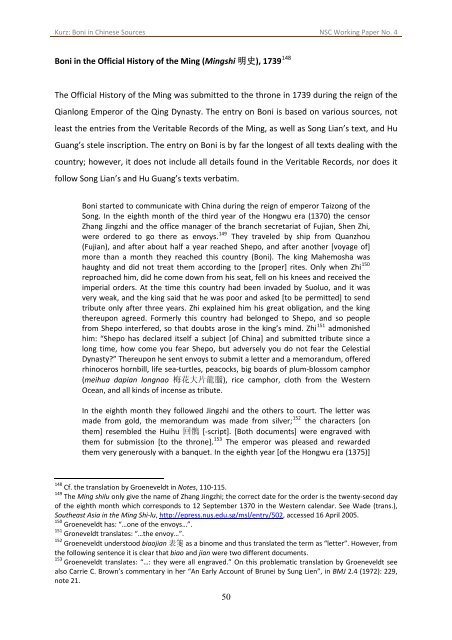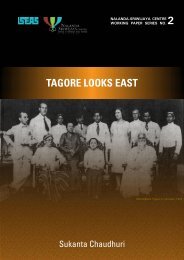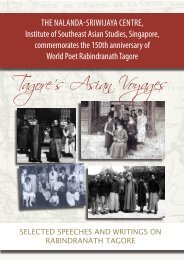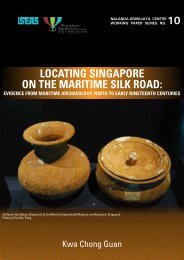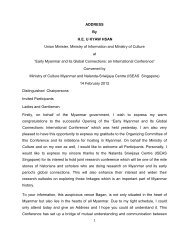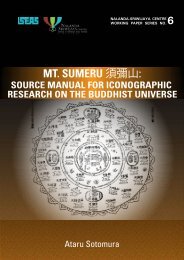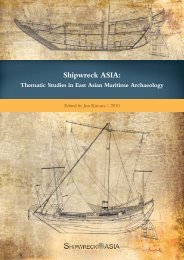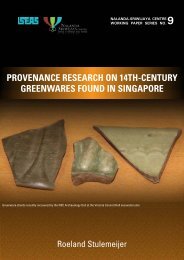Kurz: <strong>Boni</strong> <strong>in</strong> Ch<strong>in</strong>ese <strong>Sources</strong> NSC Work<strong>in</strong>g Paper No. 4<strong>Boni</strong> <strong>in</strong> the Official History of the M<strong>in</strong>g (M<strong>in</strong>gshi 明 史 ), 1739 148The Official History of the M<strong>in</strong>g was submitted to the throne <strong>in</strong> 1739 dur<strong>in</strong>g the reign of theQianlong Emperor of the Q<strong>in</strong>g Dynasty. The entry on <strong>Boni</strong> is based on various sources, notleast the entries from the Veritable Records of the M<strong>in</strong>g, as well as Song Lian’s text, and HuGuang’s stele <strong>in</strong>scription. The entry on <strong>Boni</strong> is by far the longest of all texts deal<strong>in</strong>g with thecountry; however, it does not <strong>in</strong>clude all details found <strong>in</strong> the Veritable Records, nor does itfollow Song Lian’s and Hu Guang’s texts verbatim.<strong>Boni</strong> started to communicate with Ch<strong>in</strong>a dur<strong>in</strong>g the reign of emperor Taizong of theSong. In the eighth month of the third year of the Hongwu era (1370) the censorZhang J<strong>in</strong>gzhi and the office manager of the branch secretariat of Fujian, Shen Zhi,were ordered to go there as envoys. 149 They traveled by ship from Quanzhou(Fujian), and after about half a year reached Shepo, and after another [voyage of]more than a month they reached this country (<strong>Boni</strong>). The k<strong>in</strong>g Mahemosha washaughty and did not treat them accord<strong>in</strong>g to the [proper] rites. Only when Zhi 150reproached him, did he come down from his seat, fell on his knees and received theimperial orders. At the time this country had been <strong>in</strong>vaded by Suoluo, and it wasvery weak, and the k<strong>in</strong>g said that he was poor and asked [to be permitted] to sendtribute only after three years. Zhi expla<strong>in</strong>ed him his great obligation, and the k<strong>in</strong>gthereupon agreed. Formerly this country had belonged to Shepo, and so peoplefrom Shepo <strong>in</strong>terfered, so that doubts arose <strong>in</strong> the k<strong>in</strong>g’s m<strong>in</strong>d. Zhi 151 admonishedhim: “Shepo has declared itself a subject [of Ch<strong>in</strong>a] and submitted tribute s<strong>in</strong>ce along time, how come you fear Shepo, but adversely you do not fear the CelestialDynasty?” Thereupon he sent envoys to submit a letter and a memorandum, offeredrh<strong>in</strong>oceros hornbill, life sea‐turtles, peacocks, big boards of plum‐blossom camphor(meihua dapian longnao 梅 花 大 片 龍 腦 ), rice camphor, cloth from the WesternOcean, and all k<strong>in</strong>ds of <strong>in</strong>cense as tribute.In the eighth month they followed J<strong>in</strong>gzhi and the others to court. The letter wasmade from gold, the memorandum was made from silver; 152 the characters [onthem] resembled the Huihu 回 鶻 [‐script]. [Both documents] were engraved withthem for submission [to the throne]. 153 The emperor was pleased and rewardedthem very generously with a banquet. In the eighth year [of the Hongwu era (1375)]148 Cf. the translation by Groeneveldt <strong>in</strong> Notes, 110‐115.149 The M<strong>in</strong>g shilu only give the name of Zhang J<strong>in</strong>gzhi; the correct date for the order is the twenty‐second dayof the eighth month which corresponds to 12 September 1370 <strong>in</strong> the Western calendar. See Wade (trans.),Southeast Asia <strong>in</strong> the M<strong>in</strong>g Shi‐lu, http://epress.nus.edu.sg/msl/entry/502, accessed 16 April 2005.150 Groeneveldt has: “…one of the envoys…”.151 Groneveldt translates: “…the envoy…”.152 Groeneveldt understood biaojian 表 箋 as a b<strong>in</strong>ome and thus translated the term as “letter”. However, fromthe follow<strong>in</strong>g sentence it is clear that biao and jian were two different documents.153 Groeneveldt translates: “…: they were all engraved.” On this problematic translation by Groeneveldt seealso Carrie C. Brown’s commentary <strong>in</strong> her “An Early Account of Brunei by Sung Lien”, <strong>in</strong> BMJ 2.4 (1972): 229,note 21.50
Kurz: <strong>Boni</strong> <strong>in</strong> Ch<strong>in</strong>ese <strong>Sources</strong> NSC Work<strong>in</strong>g Paper No. 4it was ordered that the mounta<strong>in</strong>s and rivers of this country should be <strong>in</strong>cluded <strong>in</strong>the sacrifices to the mounta<strong>in</strong>s and rivers of Fujian.In the w<strong>in</strong>ter of the third year of the Yongle era (1405), the k<strong>in</strong>g Manarejiana sentenvoys with tribute, and officials were sent [from the M<strong>in</strong>g court] to confer uponhim the title of k<strong>in</strong>g, present him with a seal, official credentials, 154 and a tally(fukan 符 勘 ), together with multicoloured silks (caibi 綵 幣 ), brocade andembroidered silk. The k<strong>in</strong>g was very delighted and with his consort, his youngerbrothers and sisters, his sons and daughters took sail and came to court. When hereached Fujian, the local senior official (shouchen 守 臣 ) notified [the court]. A courteunuch was sent there who enterta<strong>in</strong>ed [the k<strong>in</strong>g] with a banquet. In every districtand prov<strong>in</strong>ce he passed through, he was given a feast. In the eighth month of thesixth year [of the Yongle era (1408] he entered the capital and met [the emperor] <strong>in</strong>an audience, and the emperor praised him. The k<strong>in</strong>g knelt and made the follow<strong>in</strong>gspeech: “Your Majesty has received the precious mandate from Heaven and Youhave unified the ten thousand places. I live far away on an island <strong>in</strong> the ocean andyet I have received Your favour, hav<strong>in</strong>g been conferred rank and title. It is onaccount of this, that the seasons appear <strong>in</strong> perfect order; that the harvests arerepeatedly plentiful; that the people are not harmed by catastrophes; that preciousand extraord<strong>in</strong>ary th<strong>in</strong>gs have appeared <strong>in</strong> the mounta<strong>in</strong>s and rivers; and that plantsand trees, birds and beasts have also all multiplied. The old men <strong>in</strong> my country allsay that this came about through the protection of the sage son of heaven. I, yoursubject, want to behold the face of the sun and to show my humble upright s<strong>in</strong>cerity.I have not feared the dangers of a long voyage, and have led my family and myofficials to the capital to present my thanks.” The emperor sent his best wishesseveral times and ordered that the letter and the gifts of the k<strong>in</strong>g and his consorts 155that had entered the palace, be displayed <strong>in</strong> the Wenhua Hall. The k<strong>in</strong>g went to thehall and proceeded to present them, and consequently the k<strong>in</strong>g, his consorts, andeveryone below them were all given caps, belts and suits of garments. The emperorconsequently enterta<strong>in</strong>ed the k<strong>in</strong>g with a banquet at the Fengtian Gate, while theconsorts and the others were enterta<strong>in</strong>ed at a different place. When the ceremonieswere concluded they were escorted back to the Interpreters Institute. Officials fromthe M<strong>in</strong>istry of Rites asked about the [proper] ceremonies for the k<strong>in</strong>g’s visit to theimperial pr<strong>in</strong>ces, and the emperor ordered that the ceremonies appropriate fordukes and marquises should be followed [for the k<strong>in</strong>g]. Follow<strong>in</strong>g this [the emperor]conferred upon the k<strong>in</strong>g <strong>in</strong>signia of rank 156 , chairs, silver utensils, umbrellas and fans,horses with saddles <strong>in</strong>laid with gold, and ten suits of dresses. All the rest receivedpresents accord<strong>in</strong>g to their rank.In the tenth month the k<strong>in</strong>g died at the Interpreters Institute. The emperor mournedhis death and adjourned court bus<strong>in</strong>ess for three days. He sent officials to performsacrifices and provided the silk [to pay for the funeral]. The heir apparent and theimperial pr<strong>in</strong>ces sent all [officials] to perform sacrifices. Officials prepared a coff<strong>in</strong>and burial objects and [the k<strong>in</strong>g] was buried at Shizigang outside the Ande Gate,where a stele was erected at the spirit path. Moreover, a shr<strong>in</strong>e was built at the side154 Note that the Ch<strong>in</strong>ese text <strong>in</strong> the Zhonghua shuju edition wrongly punctuates this sentence by separat<strong>in</strong>gthe two characters gao and chi. The comma should be placed after chi.155 Groeneveldt translates: “… gave orders that the letter to the Empress…” In the text, there is no mention ofsuch a letter and the two characters <strong>in</strong> question wang fei 王 妃 clearly denote the ruler of <strong>Boni</strong> and his consort.156 These were items such as banners, halberds and pennants.51


